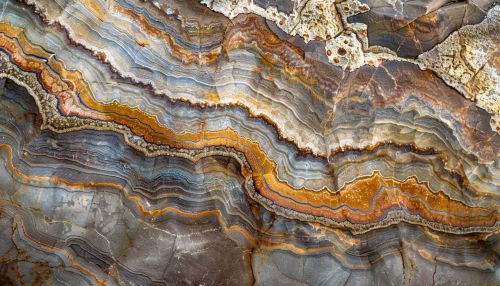Metasomatism
Introduction
Metasomatism is a geological phenomenon involving the chemical alteration of a rock by hydrothermal and other fluids. This process results in the introduction or removal of chemical elements and/or the structural reorganization of the rock's minerals. Metasomatism can occur via the action of hydrothermal fluids from an igneous or metamorphic source. In the igneous environment, metasomatism creates skarns, greisens, and other types of ore deposits. In the metamorphic environment, metasomatism results in the formation of metasomatic rocks such as marble and quartzite.


Process of Metasomatism
The process of metasomatism is driven by the introduction of chemically active fluids into a rock mass. These fluids can originate from magmatic, metamorphic, meteoric, marine, or even a possible mantle or crustal source. The fluids are usually major carriers of heat and mass within the Earth's crust. The chemical components of the fluids can react with the minerals in the rock, leading to the dissolution, precipitation, and growth of minerals. This can result in significant changes in the rock's mineralogy and texture, a process known as metasomatic alteration.
Types of Metasomatism
There are several types of metasomatism, including contact, regional, and dynamic metasomatism. Each type is characterized by specific conditions of pressure, temperature, and fluid composition.
Contact Metasomatism
Contact metasomatism occurs near the contact of an igneous intrusion with the surrounding rock. The high temperatures associated with the intrusion drive the circulation of fluids, leading to chemical reactions that alter the rock. This type of metasomatism is often associated with the formation of ore deposits, such as copper, lead, and zinc.
Regional Metasomatism
Regional metasomatism is a large-scale process that occurs over a wide area, typically associated with mountain-building events. This type of metasomatism involves the alteration of large volumes of rock by fluids that are driven by large-scale geologic processes, such as subduction or the intrusion of large bodies of magma.
Dynamic Metasomatism
Dynamic metasomatism, also known as metasomatism at seismic depths, occurs when rocks are chemically altered by fluids that are mobilized by seismic activity. This type of metasomatism can lead to the formation of rare, high-pressure minerals.
Metasomatic Textures
Metasomatic textures refer to the changes in the physical structure of the rock that accompany metasomatic alteration. These changes can include the development of new minerals, the growth of existing minerals, and the alignment of minerals into distinctive patterns. The study of these textures can provide valuable insights into the history of fluid-rock interactions and the conditions under which metasomatism occurred.
Metasomatism and Ore Deposits
Metasomatism plays a crucial role in the formation of many types of ore deposits. The fluids involved in metasomatism can carry and deposit economically important elements, such as copper, gold, and zinc. The study of metasomatic processes can therefore have important implications for economic geology and mineral exploration.
